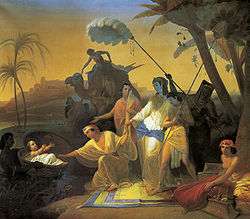


The ark of bulrushes (Hebrew: תבת גמא, romanized: têḇaṯ gōme) was a container which, according to the episode known as the finding of Moses in the biblical Book of Exodus, carried the infant Moses.
The ark, containing the three-month-old baby Moses, was placed in reeds by the river bank[1] (presumably the Nile) to protect him from the Egyptian mandate to drown every male Hebrew child,[2] and discovered there by Pharaoh's daughter.
The ark is described as being daubed with asphalt and pitch, and the English word "ark" is a translation of the Hebrew תֵּבָה (tevah, modern teiva), the same word used for Noah's Ark. According to Irving Finkel, the word tevah is nearly identical to the Babylonian word for an oblong boat (ṭubbû), especially given that "v" and "b" are the same letter in Hebrew: bet (ב).[3]
The "bulrushes" (Hebrew: גֹּ֫מֶא gome) were likely to have been papyrus stalks (Cyperus papyrus), daubed with bitumen and pitch.
A similar but earlier story is told of Sargon of Akkad.[4]
|
| |
|---|---|
| Chapters |
|
| People |
|
| Objects |
|
| Places |
|
| Torah readings |
|
| Sources |
|
| Textual analysis |
|
| Manuscripts |
|
| Phrases |
|
| Events |
|